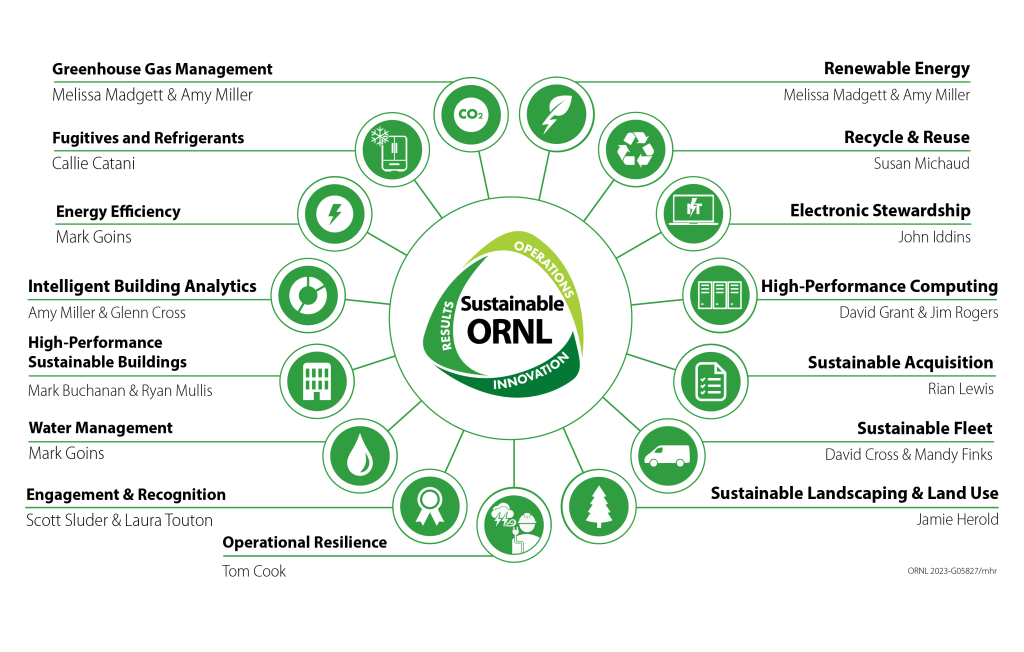“We are proud to ensure reliable, safe operations that help ORNL perform some of the most important research and development in the world,” Facilities and Operations Director Jimmy Stone said. “Sustainable ORNL helps us to lead by example by making sure our buildings, vehicles, and maintenance programs are not only clean and energy efficient but that they use the most current technology and approaches available.”
ORNL is a DOE research facility operation, established and sustained to deliver the scientific discoveries and technological innovations needed to realize solutions in energy and national security. Established in 1943 during World War II as part of the Manhattan Project, ORNL is the largest DOE science laboratory. ORNL, managed by UT-Battelle LLC, executes the widest range of mission capabilities of any Office of Science site. ORNL is engaged in an extensive range of activities that support the DOE mission: "to ensure American's security and prosperity by addressing its energy, environmental, and nuclear challenges through transformative science and technology solutions." To execute these activities, ORNL is tasked with managing the most extraordinary set of distinctive scientific facilities and equipment within the DOE. With sustainable responses to national priorities, ORNL has delivered over 75 years of continuous operations, consisting of facilities with commissioning dates ranging from the 1940s until now.
With such a wide range of building types, conventional energy and water savings practices are not always enough to deliver successive results in efficient operations. This diverse and unique set of major facilities, totaling more than 5.8 million square feet, requires an innovative program to accomplish advancements in operational efficiencies supported by all stakeholders, from the leaders to the most engaged employees. Continuous improvements in operational and business processes must be integrated into the fabric of the ORNL culture to maximize the return from the investment made in modernizing facilities and equipment. The Sustainable ORNL program promotes the legacy of system-wide best practices, management commitment, and employee engagement that will lead ORNL into a future of efficient, sustainable, and resilient operations. ORNL leadership, facilities management, and Sustainable ORNL champions receive regular status reports on the progress of each project and program area (also known as roadmaps), and period summary reports containing program activities and results.
The Sustainable ORNL Roadmap structure has been streamlined to demonstrate 15 vital projects. The graphic depiction below illustrates the roadmap assignments and was designed to indicate that each project contributes to the wellbeing of the whole. Continuous employee engagement and regular status reports confirm the ideals of the program.

The roadmap structure is not static; as the science mission advances and the needs of the organization evolve, the Sustainable ORNL roadmap structure elements are modified to align with developing priorities. In FY 2022, Sustainable ORNL roadmap changes leading into FY 2023 to better align ORNL to support the new requirements that have been issued.
In 2021, EO 14008, Tackling the Climate Crisis at Home and Abroad, established broad strategies calling for federal agencies to take the lead in confronting the climate crisis, engage in the formation of a net-zero economy, and enhance operational resilience at federal facilities. To respond to DOE priorities, ORNL requires a comprehensive cross-cutting process to respond to EO 14008 and enhance climate mitigation efforts.
Net-zero initiatives do not operate in isolation; rather, they work in conjunction with other priorities to reach a number of agency objectives. Throughout the ORNL campus, projects are evaluated on several sustainability priorities, including energy and water savings (and cost savings) from energy conservation measures (ECMs), net-zero initiatives, and operational resilience. ORNL has an opportunity and a responsibility to lead by example and integrate climate and sustainability into all aspects of its operations.

